Your cart is currently empty!
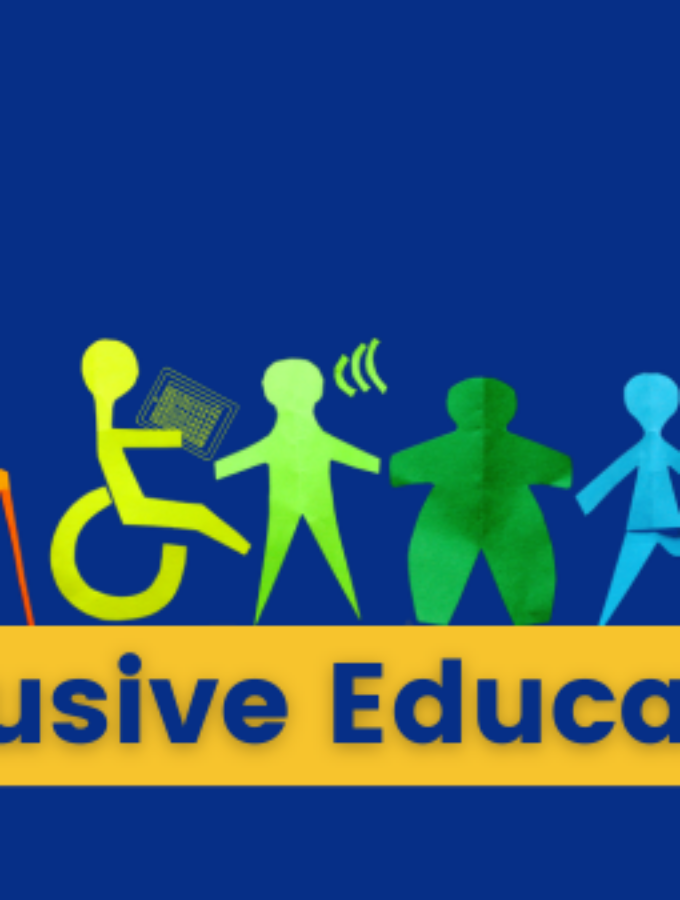
Building an inclusive learning environment is a commitment to recognising and addressing the diverse needs of every child. It also means creating an environment where all children feel welcome, valued and that they belong, without having to ask!
Being intentional in the set up of your learning environment will drive successful outcomes in engagement and positive behaviour. Children who experience an inclusive learning environment develop not only academically, but also socially and emotionally.
Just as inclusive architecture focuses on creating environments that are usable by all people – in education, resources and adjustments that may be a priority for some, can be used by all to enable opportunity.
When you minimise the barriers to learning and create an inclusive environment, ALL students are set up for success. This approach is particularly important in the early childhood setting, when needs may not yet have been identified and children are at different stages of development, with varying abilities.
There’s another buzzword you may have heard in education – Universal Design for Learning (UDL).
UDL guides the creation of learning outcomes, resources and assessments that work for everyone. While some children will need more individualised adjustments and tools to participate in an environment, UDL closes the gap that needs to be filled by an individual.
For example, height adjustable desks in a classroom mean that a child who uses a wheelchair some or all of the time, can still sit at the same desks and in the same space as all of the other children. In addition, taller children and smaller children can also set the desk to the height that best suits them rather than needing a cushion or having to sit at a different desk. These children ‘just fit’ in their classroom and there is no requirement to apply for extra funding, have special meetings to organise an appropriate desk, nor to encounter challenges when the class moves to a different room where the ‘special desk’ is not available. There may also be some days where all children would benefit from alternating between standing and sitting.
Communication is no different. Though the majority of children in our childcare and school settings communicate with spoken words, many need or prefer other methods such as sign, symbols, typing, body language and more. Many children benefit from alternate methods some of the time, or to enhance their expression or understanding through visual channels.
Just as PowerPoint, photos, maps and pictures add visual meaning and interest to our conversations and learning, visual displays can do the same for our children by expanding on the spoken word. All children can benefit from the inclusion of symbolic communication displays to enhance understanding, idea generation and expressive communication. With varied methods of communication available, those who need or prefer to use them will ‘just fit’ into their learning environment too. The communication displays also have a beneficial impact on those who may not speak English as a first language, may be shy, or as yet have not been identified as someone who may benefit from a personalised communication system.
Remember that preferences are part of the equality equation and are an important component in creating your inclusive learning environment. Taking preferences into account is crucial because it acknowledges that children have different ways of processing information and engaging with their surroundings. And those preferences may change based on the activity or environment.
Considering preferences promotes a sense of autonomy and agency among children. When children have choices in how they learn and demonstrate their understanding, they are more likely to be actively engaged and invested in their learning process. It’s empowering to feel valued and supported when exploring your own unique interests and strengths!
As we aim to create an inclusive world that includes communication accessibility opportunities, we need to ensure that symbolic communication starts in the early years as a component of UDL (also referred to as Tier 1 support). We can not know which children may need or prefer to use symbols for communication later in life, nor those who benefit from the symbols to enhance their comprehension of speech. Rather than waiting to find out, let’s give opportunities early.
It’s better to be glad we did, than to regret we didn’t
Integrating symbolic communication into existing curricula can be done with a few simple adjustments. By incorporating visual aids alongside other forms of communication, all children will feel empowered to express themselves effectively. And as we mentioned earlier, embracing inclusive communication practices early, not only benefits people with specific needs, but fosters empathy and understanding among all children preparing them for a diverse and interconnected world.
At Two Way Street, we’ve started our quest to ensure that people see symbolic communication as ‘just part of it’ rather than it being different or special.
Our first Communication For All Pack is available now, for the Early Childhood setting. We’ve done all the work, so you can create a truly communication inclusive environment. The pack includes symbolic communication displays for common activities in kindy or childcare settings, along with posters that value, respect and represent symbolic communication, plus downloadable templates to help you implement inclusive communication practices.
Take a closer look at the Communication For All Pack – Early Childhood. And get in touch with the team at Two Way Street for more information.
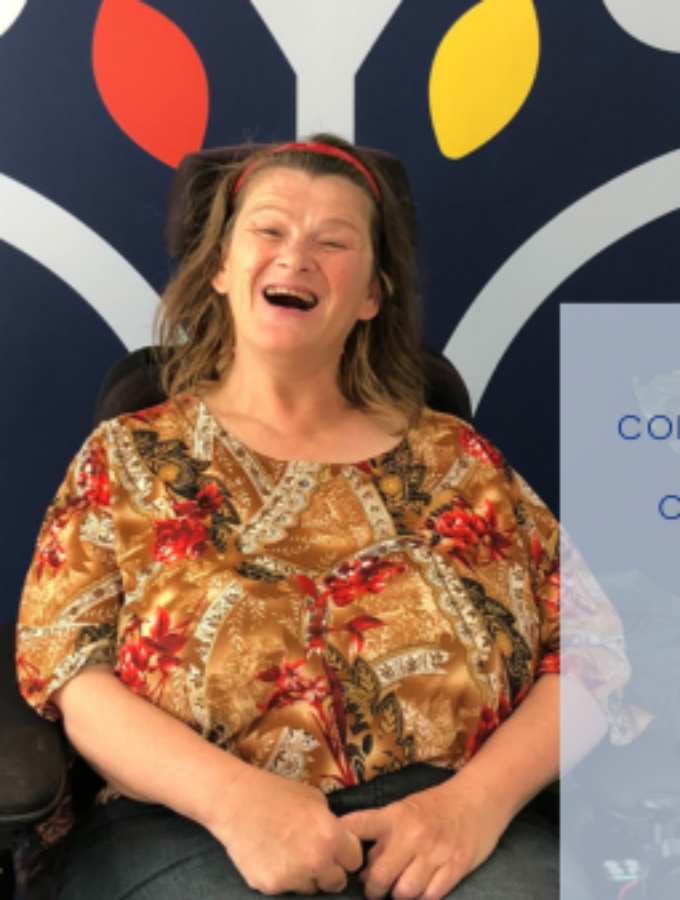
I was born with Cerebral Palsy and grew up using my natural speech with what I like to call a ‘Cerebral Palsy accent’ (some of you may call this a communication disability). It was an era when talking freely about emotions just didn’t occur. Limited options for speech generating devices made it difficult for me to communicate effectively, and when I did try to express my feelings, the outcomes were often disastrous for me and those around me.
My parents did their best to create a happy and nurturing home environment. Dinner time was a fabulous time of sharing laughter and conversations, but it would have been immensely valuable if my parents had access to a program like Talking About The Important Stuff to support my emotional development, just as they could with my brother. This would have provided strategies not only to talk about emotions, but to provide children with complex communication needs (CCN) with avenues to express thoughts and feelings, just like any other child. We now recognise the significance of supporting parents and caregivers in this journey as well.
As a child with communication difficulties, my Dad tended to over-protect me, wrapping me in cotton wool as the saying goes! However, I have come to appreciate the wisdom in quotes from people with lived experience of CCN in Talking About The Important Stuff. Quotes like “throw them out of their wheelchair (gently) and let them eat dirt” and “the kid with disability should not be the centre of love all the time”. These quotes serve as powerful reminders that children with CCN deserve to experience everyday life and be exposed to the realities of the world, just like any other child. Over-protection hinders our growth and independence, whereas providing us with opportunities to learn, explore, and be understood promotes our emotional development and self-empowerment.
While it is crucial to start conversations about “the important stuff” during childhood, I am a strong advocate for providing tools and strategies that continue to support individuals with CCN throughout adulthood. Conversations around independence, personal safety, and self-empowerment are long overdue for anyone with a disability, and they hold even greater significance for people with CCN.
Speech Pathologists can work with children and adults with CCN to support them to build on their natural speech. They can also support by introducing Augmentative and Alternative Communication (AAC) as a way to supplement this speech or to give them another way of communicating. AAC systems can take many forms e.g., sign, aided language displays (ALDs), comprehensive communication books (PODD), speech generating devices and many more.
Thinking back to when I was young and having speech therapy, I remember having to listen to the words on a flash card, repeat the words and then sound out each word as I said them. I’m pleased to say, especially during Speech Pathology Week 2023, that nowadays speech therapy looks different. Speechies are much more involved in advocating what works best for their clients and ensuring that all ways that a person communicates are valued. This is important, especially when considering the future “voice” for their individual client. #SPWeek
Through my journey with communication disabilities, I have come to realise the immense power of words in shaping our understanding of one another. By embracing the voices of children with CCN and providing them with the means to express themselves, alongside continued support throughout adulthood, we create opportunities for meaningful connections and a life that flourishes with possibilities.
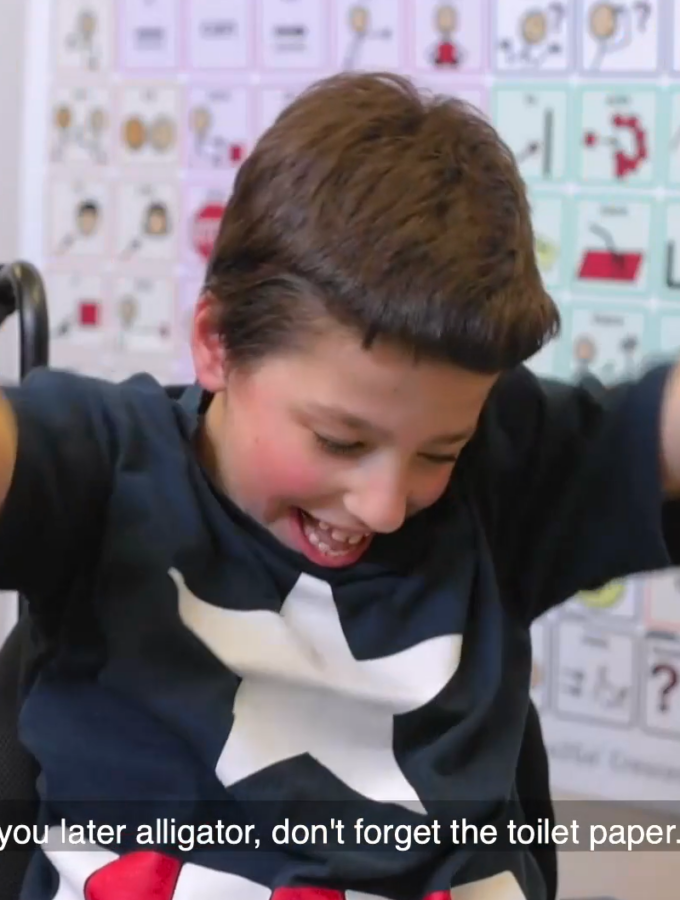
We were thrilled to collaborate with Positive Partnerships to create a series of videos showing young people with complex communication needs using their AAC (Augmentative and Alternative Communication) systems out and about. They’re chatting at home, school, and out in their communities.
These videos are available under Creative Commons, so can be shared and used for training in your workshops or at your events with appropriate citation.
Below are a few of the videos. CLICK HERE to view all 18 videos.
We hope these videos highlight how a robust communication system can provide your young person with autonomy, belonging, connection and opportunity!
Copyright Australian Government Department of Education, Skills and Employment 2008 to present, unless otherwise indicated. This material was downloaded from the Positive Partnerships website (https://www.positivepartnerships.com.au) on 10 March 2022 and was not modified. The material is licensed under CC BY 4.0. The Australian Government Department of Education, Skills and Employment, Autism Spectrum Australia and Positive Partnerships do not endorse any product or service that uses this material, make any representations as to the quality of such products or services, or is affiliated with or sponsors the provider.
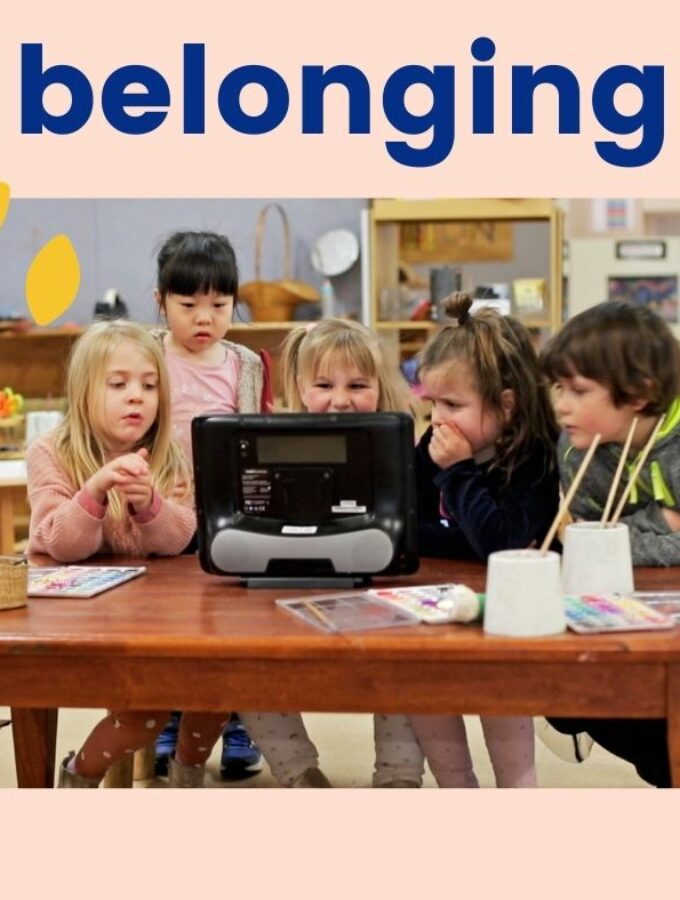
A sense of belonging is at the heart of inclusion. At Two Way Street, we believe this to be true. Inclusion is about more than a place, about more than just being in the same room as your peers. Inclusion is about a sense of belonging, about not only being accepted but about being valued and appreciated for who you are.
For students with complex communication needs, this also means being valued and appreciated for how they communicate, and that their voices are heard just as clearly as those of their peers. So how do we develop a sense of belonging for students with complex communication needs in inclusive schools?
To start with, we need to ensure that students with complex communication needs are able to connect with their peers and educators. When students with disability start school, there is often a lot of focus on how they will access the curriculum. But what is arguably more important is ensuring that from the outset, students with complex communication needs are able to form connections within the school community, and build and maintain relationships as they progress through their grades.
Some simple strategies to assist with building connections may include:
An important component of belonging is the sense that you are accepted and valued by your community. For students with complex communication needs, the presence of AAC within the environment sends the message that their language is important, and valued within the school community. As a speech pathologist working in schools, I find that this works best when symbolic language, perhaps in the form of an aided language display (ALD), is embedded into classroom routines and activities that already exist. This way, AAC becomes an enhancing component of existing activities, rather than an additional activity that educators have to fit into their day. Here are just some examples of how AAC can be embedded into the school community (all of these examples are from inclusive kindergartens or schools in South Australia).






Embedding AAC tools within the environment is an important starting point in developing a sense of belonging for students with complex communication needs. The next step is to support other people in the environment to use the communication tools during interactions. This should include everyone from the teachers, teacher aides, school administration staff, and perhaps most importantly, peers. When other people use a child’s communication system (or other AAC tools) while interacting with them, it implies to the student with complex communication needs that how they communicate is important, that their voice is valued, and that they belong.
Running a formal peer training session can be a useful strategy in supporting students to develop familiarity with their peer’s communication system, and building their confidence in interacting with their peer. It is important to note that peer training sessions should be developed and run in collaboration with the student with complex communication needs and their family.
Activities in peer training sessions can include:


When students feel as though they belong, they feel accepted and valued by their community. It is therefore the shared responsibility of individuals within a particular community to embrace each and every child for who they are, and to recognise their own unique strengths. For students with complex communication needs, this also means valuing how they communicate, by building a school community that understands and embraces AAC. This will allow students with complex communication needs to be who they really are; to belong, in their school communities. Because, to quote AAC user Sara Pyska, author of Inside My Outside,
“the feeling of being yourself with someone is priceless”.
To download free Aided Language Displays visit https://twowaystreet.com.au/online-learning-and-products/
For more examples of children who use AAC in inclusive settings, visit https://vimeo.com/showcase/8678812
For more information about building peer relationships for for beginning communicators in inclusive primary school settings, visit https://spaace.com.au/wp-content/uploads/2021/10/Building-Peer-Relationships-2021.pdf
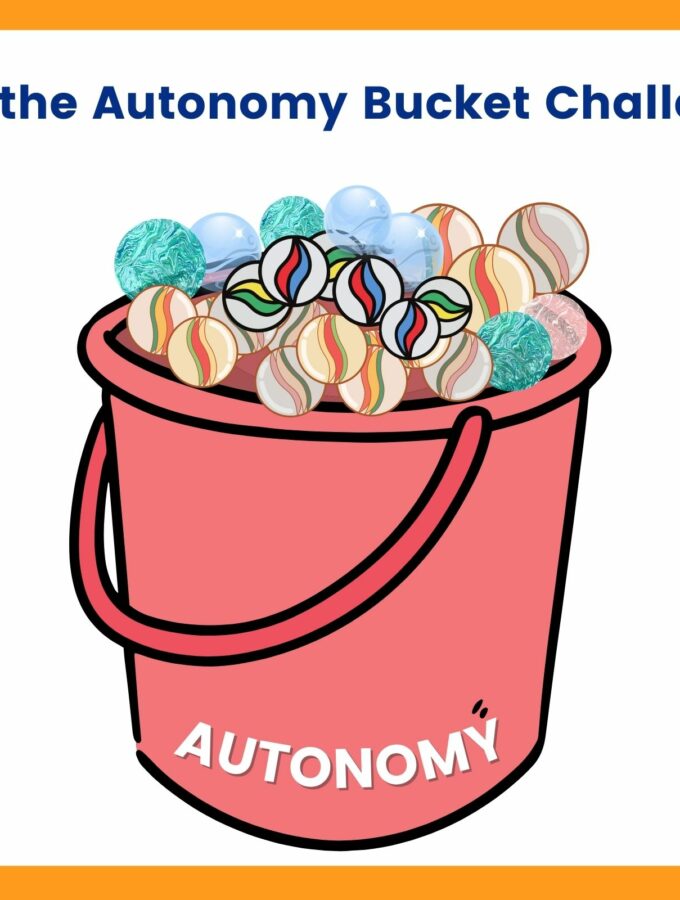
Let’s find more of those autonomy marbles…
The Merriam Webster Online Dictionary defines autonomy as:
the state of existing or acting separately from others.
Autonomy is one of the key psychological needs that drives human behaviour – it both empowers and motivates us. Within a society, we can’t always be autonomous. We are supposed to follow or comply with rules and social norms at least some of the time. Some of us seek more autonomy and choose activities that are less structured, some may even choose to resist or protest. Others may be happy to comply, or prefer to go along with someone else’s agenda some of the time. Governments the world over allow their citizens different levels of autonomy and communities, schools, workplaces and families balance autonomy and compliance all of the time. Though it is important that we comply with rules and social standards in many ways, it is autonomy that lays the foundation for motivation, engagement, and self determination. Think about the type of person you are and how often you exert your autonomy or comply with rules or standards throughout your daily life.
Now think about the person you know who has CCN (complex communication needs).
Autonomous communication is crucial to our overall autonomy. Gayle Porter (2018) describes communication autonomy as communicating according to our own intentions or, put more simply, the individual is able to say what I want to say, to whoever I want to say it to, whenever I want to say it, however I choose to say it. Consider how many times a day a person with fluent verbal speech is able to say what they are thinking, and the variety of those messages throughout our day as they interact with others.
Now think about the person you know who has CCN.
Sometimes our communication is less autonomous, and takes the form of answering questions posed by others (such as when we visit the doctor or dentist), other choosing from a list of options that someone else has prepared (eg. menu items at a restaurant, or which movie we will see at the cinema). What percentage of your daily communication would you say is like this? For me it’s easily less than about 5%.
Now think about the person you know who has CCN.
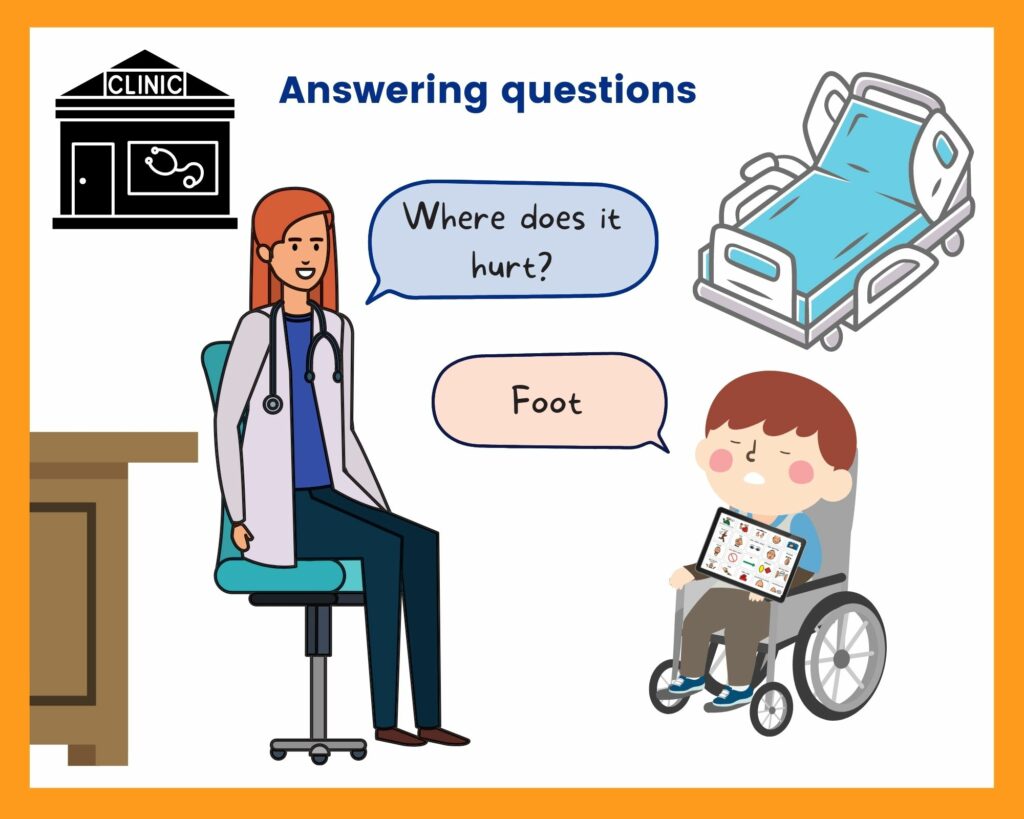
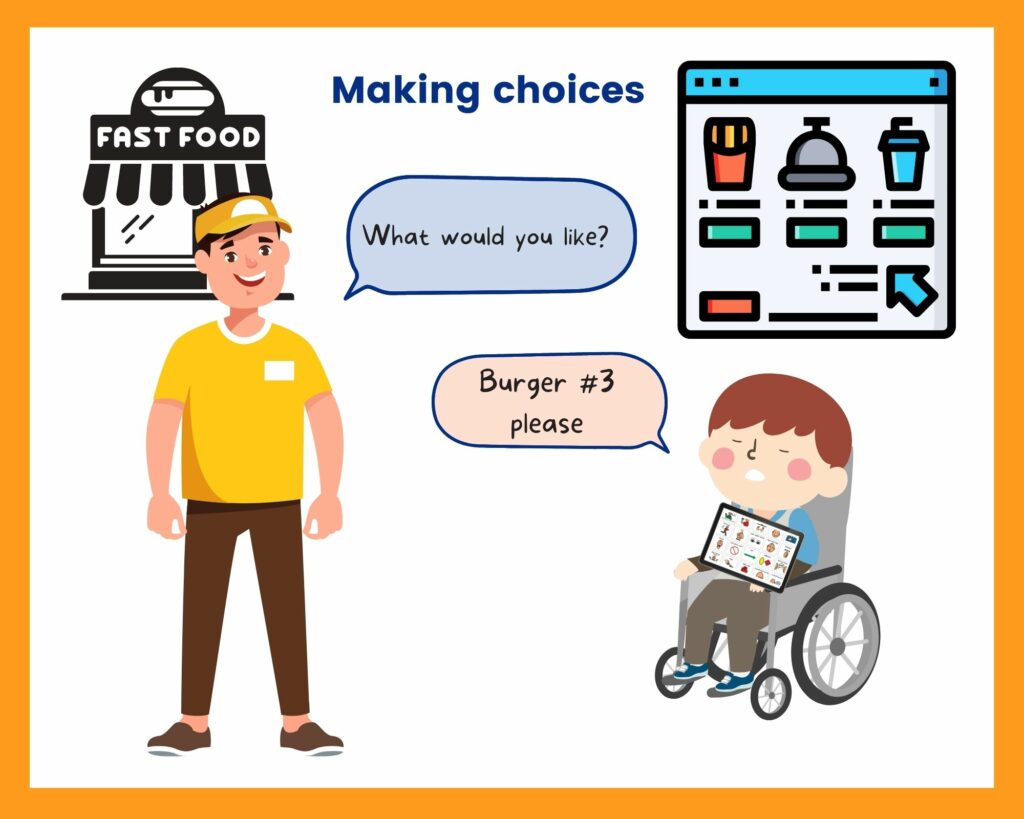
Most of us are okay with these less autonomous interactions because they are such a small percentage of our messages. As well, we often pair a compliant message with an autonomous one to make sure we maintain control of what happens to us. Here are some examples:
Now think about the person you know who has CCN.
Being able to say what we are thinking helps us feel calm and safe that we can influence what happens to us. Sometimes other people might try to predict what we are going to say and jump in before us. While this could be fun or beneficial if we are playing charades, or have just taken a bite of food, it is mostly frustrating and disempowering.
Now think about the person you know who has CCN.
Erin Sheldon (2019) described autonomy and compliance as either sides of a balance scale. She explained that whenever we are being compliant, we are not being autonomous and vice versa. Adding to one, takes away from the other. We are not autonomous when we comply with rules, or even when we have to choose from the menu at a restaurant. Of course we have a choice, but we must choose something that the restaurant has made available to choose.
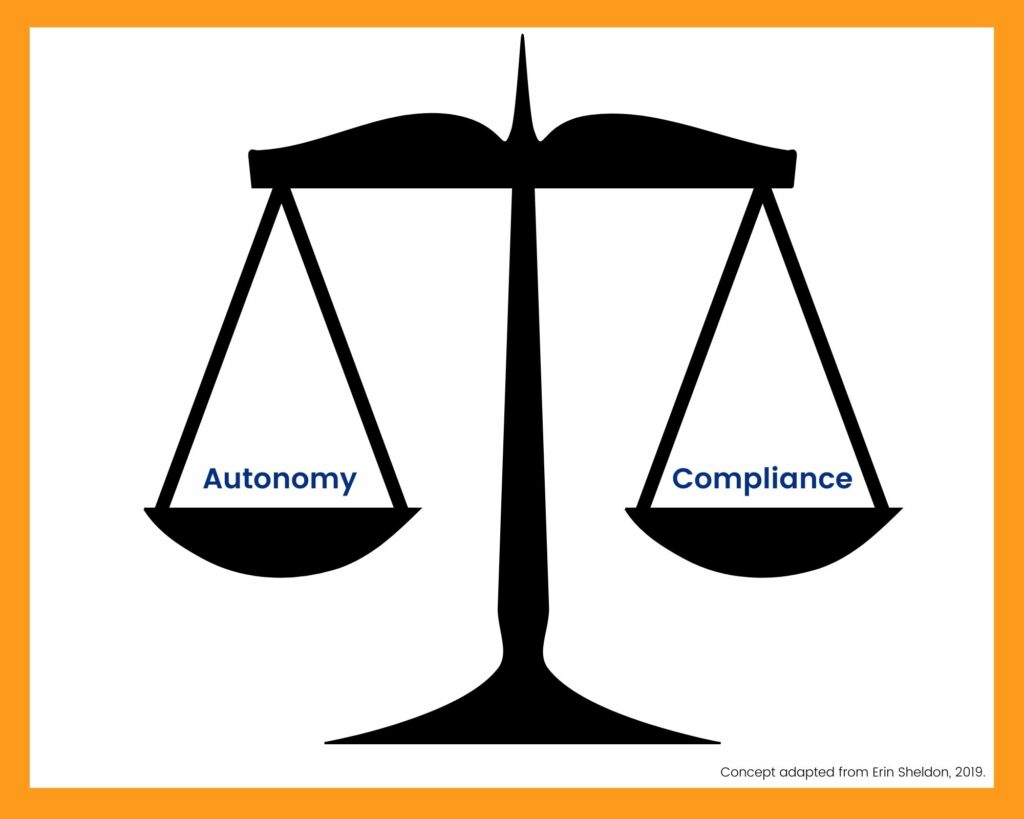
In terms of building communication autonomy, I like to think of the autonomy and compliance scales as having a bucket on each side and throughout the day we drop marbles into each bucket.
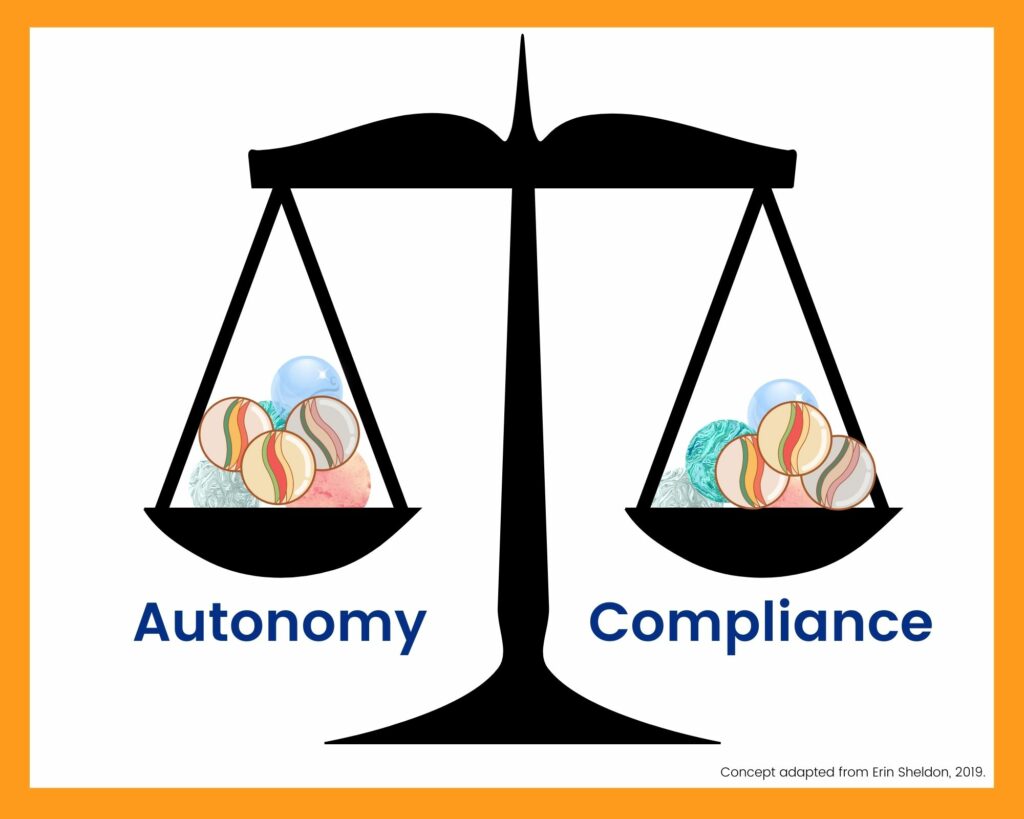
Though all of us collect compliance marbles throughout the day, we also gather a big pile of autonomy marbles to balance them out.
| Typical interactions where autonomy is paired with compliance. | Compliant messages only (answering questions or making choices) which tends to happen when someone is still developing expressive language skills. |
|---|---|
| Doctor: Where does it hurt? Patient: Well on my foot mostly but also my leg gets really itchy. But it only happens sometimes. | Doctor: Where does it hurt? Patient: Foot. Leg. |
| Waiter: What can I get for you? Diner: Does the salad have eggs in it? Waiter: Yes it does. Diner: Ok, I’ll have the stir fry instead. | Waiter: What can I get for you? Diner: Stir fry. |
| Friend: Do you want to go for a coffee? You: Sure. When? Friend: This Afternoon. What time suits you? You: Well, I have to go for a run first, so is 4pm OK” | Friend: Do you want to go for a coffee? You: Yes Friend: This Afternoon. 2pm You: Yes (and miss your run) or No (and miss the coffee). |
Now think about the person you know who has CCN.
How does their balance scale look? Often we see the autonomy marbles are in short supply, and the opportunities to collect them are even less. So our challenge is to balance the scale with autonomy marbles whenever we can.
Jasmine is a 12 year old girl. She gets up at 7am, eats breakfast and gets ready for school with the help of her parents. She catches the bus to school, arrives at 8:45 and plays in the yard til class starts at 9am. Jasmine communicates using speech and between 7am and 9am when she starts class, she is pretty much talking constantly. Anything she needs to say or tell people is autonomously spoken as many times as she chooses to say it, and often that is multiple times until she gets the response she wants, or has to change the subject. Maybe she had a bad dream, maybe she is excited about the chicks they are bringing into class today, maybe she forgot to bring her excursion note. Luckily she can tell anyone and everyone if she chooses. When she sits down for morning group and the teacher asks her questions, she is happy to answer as she feels like she has been heard and had a chance to say what she needs already.
She has already filled her bucket with autonomy marbles.
Jenna is a 12 year old girl. She gets up at 7am, eats breakfast and gets ready for school with the help of her parents. She catches the bus to school, arrives at 8:45 and plays in the yard til class starts at 9am. Jenna communicates using AAC and between 7am and 9am when she starts class, she is pretty much thinking constantly. Anything she needs to say or tell people is in her head but she has to wait until someone has the time to sit with her to listen, or remembers to get her device off charge and have it available to her. Her parents are great but given her extra needs, there is a lot more to manage in the mornings and the accessible bus comes really early! Sometimes when she is not in her wheelchair, she needs others to scan on her PODD when she has something to say, but lots of people don’t notice when she wiggles her body to say “Hey, I’ve got something to say”. Maybe she had a bad dream, maybe she is excited about the chicks they are bringing into class today, maybe she forgot to bring her excursion note. Unfortunately she can’t always tell anyone and everyone if she chooses. When she sits down for morning group and the teacher asks her questions, she might use this as an opportunity to talk about her bad dream, or maybe she has learned that she doesn’t fit in here, or that people won’t take the time to listen so she just listens but doesn’t participate.
Jenna needs some autonomy marbles in her bucket first if we want her to successfully participate in her class activities.
How do we do this?
Of course, there will be situations where we need compliance both in behaviour and communication. All of us need to answer questions and make simple choices regularly throughout our week (e.g., “Are you dining in?” or “Do you want pasta or sandwiches for lunch today?”), but we should focus more on finding as many autonomy marbles as possible to balance out the scale. We call it the Autonomy Bucket Challenge for those who are communication partners to people who have complex communication needs, and here are some ideas…
At first, autonomous messages may not always be expressed in symbolic form. We may need to watch and listen for examples of autonomy and then model the language that maps onto what they are already telling us with their body. Other times we may need to wait until the person shows us they have something to say rather than just asking them a question or trying to get them to say something.
For those who are already using symbolic language within their AAC system, try to cut back on yes/no questions and just give them an opportunity to share something, or at least ask an open rather than closed question. Maybe you could even just tell them something that’s on your mind and then give them a chance to take a turn in the conversation – or not if they choose not to, it’s up to them.
Another key technique is to let go of your own agenda. To quote Daniel H. Pink, “control leads to compliance: autonomy leads to engagement”. Oftentimes, AAC systems are used to find out what we want to know from a person rather than what they want to tell us. Consider Jasmine again, maybe we ask her “What did you do at school today?” and she ignores our question saying “My friend got a new puppy?” She is more interested in talking about the puppy than what she did at school, and will become less engaged if we keep trying to talk about school rather than the puppy.
Though we may often think that we know what a person is going to say, quite often we are wrong. If we make assumptions about what someone who uses AAC is going to say, we tend to only give them the chance to say what we thought they were going to say, not necessarily what they wanted to say.
This might happen if:

So take the challenge and see where it leads you. Think about ways that you can find autonomy marbles for the person you know who has CCN. It’s okay to include some compliance marbles along the way, but just put an autonomy marble in the other bucket first.
Here are some ways you can do this:
Just remember that we all need autonomy. If we don’t get it one way, we will look for it elsewhere. If you don’t let individuals say autonomous things they will exert their autonomy another way and this may be through body language, resistance, avoidance or even challenging behaviours.
There are so many ideas and strategies to encourage autonomous messages, we can’t put them all into this blog. Hopefully, we’ve just given you some thinking points for reflection. What we know for sure is that autonomous messages are the ‘Gold’ that we seek as we support those who are learning to communicate using AAC. The more marbles in that Autonomy bucket, the more they will be motivated to express themselves more frequently and with greater sophistication.
When we hear what someone is thinking rather than just what we want them to say, we learn who they are, we connect with them, and we have true conversations. As we gather autonomy marbles, we better understand our children, we better teach our students, and we can better support those people we are paid to assist.
Now think about the person you know who has CCN and take the Autonomy Bucket Challenge!
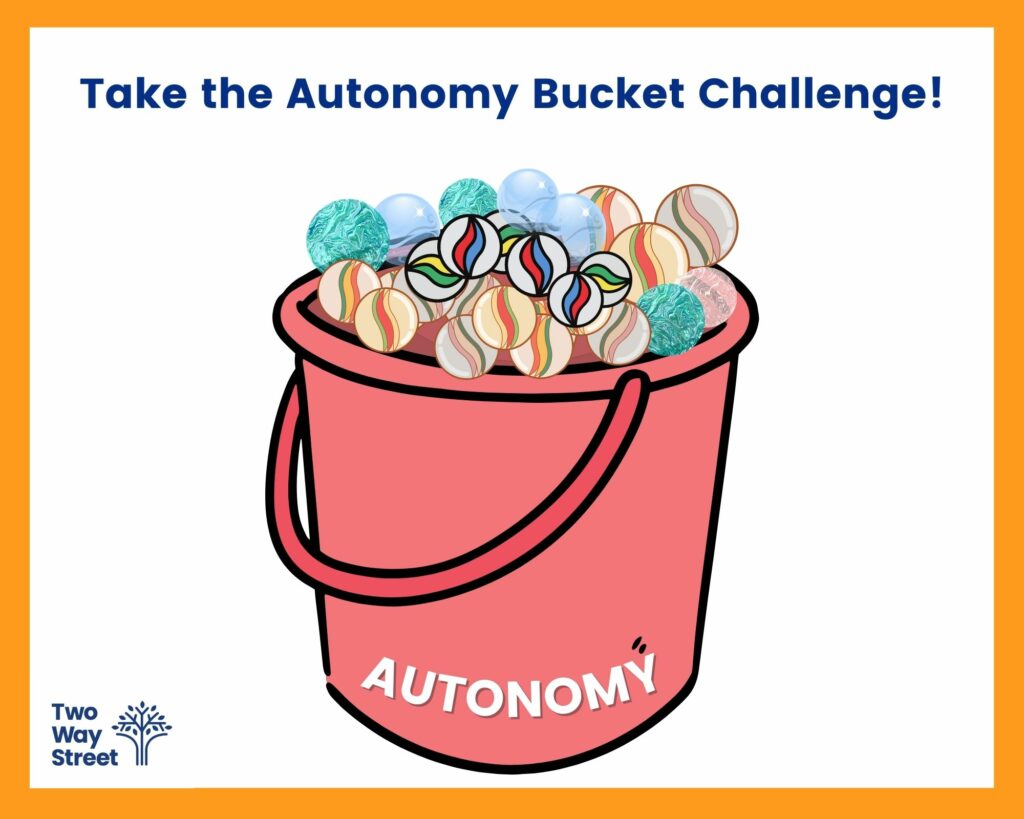
Written by: Janelle Sampson
References:
Porter, G. PODD Communication Books Introductory workshop manual © 2018
Erin Sheldon Communication for choice and control – July 11, 2019 in goodthingsinlife.org
